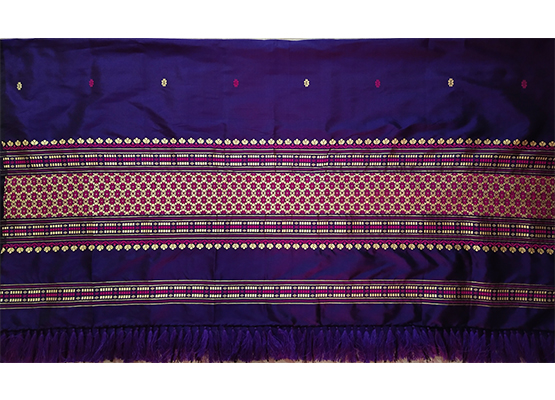
Home to three important tribal communities - the Khasis, the Jaintias and the Garos - Meghalaya is another powerhouse of traditional woven fabrics and textiles. Weaving is the main occupation of the Garo women and is taken up by almost every family in the clan. Dakmanda, a garment worn from the waist to the knee is the main item of clothing that is woven. Apart from the Dakmanda, the Garo women also weave tablecloths, bed covers and shirts. Most traditional garments are woven with the Endi (Eri) silk as it is famous for its soft texture, warmth and durability. A small village by the name of Sonidan, which consists of a hundred or so huts, is the main production center for Endi silk weaving. Jainsen, which is a traditional garment worn by Meghalayan women, is woven with local mulberry silk. Silk weaving is encouraged in a number of places for its commercial value. Endi silk weaving is carried out by most women on the conventional loin-looms, while the Garo women are also known to use the slightly more modern frame-looms.
The patterns woven on the textiles are generally colourful and vivid, using multicoloured threads within the warp and weft. Tales of local legend and folklore, local flora and fauna and other customs sacred to the tribes can be seen reflected in their designs. Shawls and wraps, scarfs, skirts, lungis, aprons, waistcoats and bodices are some of the apparels mainly produced by the state for commercial value. Apart from weaving, Meghalaya is also known for its beautifully unique embroidery work. The Embroidery is usually done on handwoven and handspun eri silk fabric. It represents the physical illustration of the trading routes in the state and is considered an expression of local cultural identity.
The fabric regularly used as base for the Khneng embroidery is the Eri silk fabric. The Eri silk is not locally woven but is instead sourced from another Meghalayan district, mainly the Ri-Bhoi district. As with weaving, the women are the majority of the population that work on embroidery, specifically Khneng embroidery. Skilful attention to detail is given to this embroidery created with basic running stitches. One distinctive feature of this embroidery technique is the thread count. The motifs are stitched starting with the middle part of the pattern and then worked their way from there count by count. This unique technique results in the even distribution of motifs throughout the fabric.

